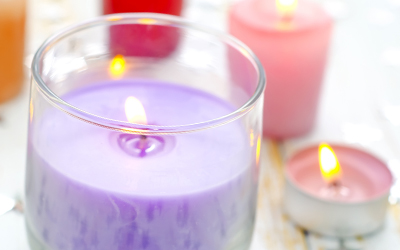
Safeguard your home against preventable fires
Keep candle safety top-of-mind every time to reduce your risk of a household fire.
Burning candles safely
In recent years, candle use in Canadian homes has grown dramatically. Though the ambiance and mood created by candle light is enjoyable – and often necessary during a power outage – it is important that you keep candle safety top-of-mind every time you light a candlewick.
The facts
- Candles are the only ignition source of house fires that shows an increase in the number of fires per year in Canada.
- The incidence of fatalities is significant compared to the small number of fires reported.
- Fires caused by candles are clearly preventable.
- Candles left unattended account for 45% of all candle fires. These fires result in millions of dollars in property damages, as well as numerous injuries and deaths each year.
Safe candle use
- Light candles carefully and keep loose clothing and hair away from the flame.
- Use candleholders that won’t burn or tip over easily. Place candleholders on a sturdy, level, uncluttered heat-resistant surface.
- Keep candlewicks trimmed to a 1/2 cm or 1/4 inch.
- Extinguish candles when they burn down to within 5 cm, or 2 inches, of their holder, or when there’s about 1 cm, or less than a 1/2 inch, of wax remaining in their container.
- Extinguish candles carefully, don’t spatter wax or fan the open flame.
- Never leave a burning candle unattended.
- Keep candles away from flammable materials and liquids.
- Keep burning candles out of reach of children and pets.
- Don’t let children play with burning candles or wax drippings.
- Don’t place burning candles near windows or doorways where a draft could bring the open flame into contact with combustible materials.
- Don’t move a burning candle.
- Use flashlights or battery-powered back-up lighting in the event of a power outage whenever possible.
If a fire happens
- Put your fire plan into action and evacuate all members of your family.
- Phone your local fire department immediately, or call 911.
- When it’s safe to do so, contact your insurance broker to arrange for an adjuster to handle your claim.
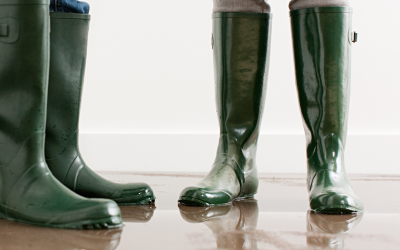
Protect your home from basement flooding
Reduce your risk of flooding and sewer backup with these simple home modifications.
Sewer back up results when the volume of water and sewage flowing into a sewer system exceeds its capacity. Other causes of sewer back up include blocked sewer connections caused by tree roots, collapsed sewer pipes or improper use of the sewer system.
How to help prevent a sewer back up in your home
- Keep sewer caps on all basement sewer outlets (including your floor drain, washer stack, sump hole, etc.) during rainstorms.
- Install a sump pump and discharge drainage onto your lawn or driveway.
- Install an automatic sewer backwater flow valve.
- Disconnect all rainwater downspouts from your basement sewer system and cap disconnected standpipes.
- Extend all rainwater downspouts away from the foundation of your home.
- Ensure the flow of surface water is directed away from the foundation of your home and the foundations of your neighbours’ homes.
- Avoid using water during heavy downpours.
What to do if a sewer back up occurs
- During a rainstorm, check your basement frequently. If it begins to flood, move your belongings upstairs or to a dry area to keep them safe.
- Contact your broker as soon as possible and they will arrange for an adjuster to contact you.
- Don’t throw anything out. Store damaged items in a reasonably safe place so the adjuster can see them when they arrive.
- Prepare an itemized account of all damaged items and their value. Include receipts or proof of purchase for larger items.
Cleaning up after a sewer back up
- Clean up as soon as possible. Seek professional advice on how to clean up and take whatever steps you can to minimize the extent of your loss.
- Don’t touch electrical systems or panels until you know it is safe to do so, especially in wet or damp conditions.
- Move damaged belongings to a dry area with good ventilation.
- Dispose of anything that has been contaminated by sewer back up that might be a health hazard. Make a detailed list of everything and take several photographs, or make a videotape, to assist in the settlement of your claim.
- Have any appliances (including furnaces) that have come in contact with water checked by a qualified electrician, dealer or serviceman before you use them.
- Disinfect all articles that have come in contact with flood or sewer water.
- Let rooms dry thoroughly before cleaning and repainting.
- Use a stiff broom or brush to sweep dirt from rugs and carpets. Then clean using a good rug shampoo that contains a disinfectant.
- Remove drawers from furniture before the wood swells. Dry furniture slowly and away from direct heat or sunlight, to avoid warping.
- Move upholstered furniture outdoors to air. When dry, vacuum thoroughly and then use a good upholstery shampoo that contains a disinfectant.
- Dry all books and papers slowing, away from direct heat or sunlight.
- Wash clothing several times, adding a bleach or disinfectant to the wash cycle if the fabric permits.
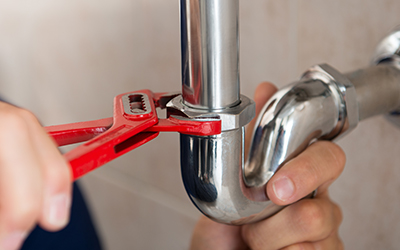
Water escape and rupture
Water damage repairs are very costly and, if not done properly, can contribute to moulds and other known health hazards.
Insurance provides coverage for the damage resulting from water escape and rupture, but it’s the responsibility of the homeowner to correct the problem and prevent it from happening again – or better yet, from happening at all.
The following will help you understand what water escape and rupture means in regard to damages and insurance claims:
- Water escape means the accidental discharge or overflow of water or steam from plumbing, heating, fire sprinkler or air conditioning systems, household appliances, household appliances, a swimming pool or its attached equipment, aquariums, waterbeds or a public water main.
- Rupture means damage to plumbing, heating, fire sprinkler or air conditioning systems within your dwelling caused by sudden and accidental bursting, tearing apart, cracking, burning or bulging of the system, due to the pressure of, or lack of, water or steam.
Prevention tips
There are a number of tips to help prevent water escape and rupture losses from occurring in your home. These include:
- Periodically checking water lines and connections for corrosion or leaks.
- Periodically inspect your washing machine hoses for pliability and check for cracking of the rubber. If there are any signs of wear or fatigue, or you cannot recall the last time they were changed, it’s best to replace them.
- If you notice a drastic change in water pressure, take the time to look for the reason.
- Turn off your water supply valve when you are away from your home for more than a day.
What to do if a water escape or rupture occurs
- Shut off the water supply to the leaking or burst waterline.
- Move your belongings out of the wet areas of your home.
- Arrange for a qualified plumber to repair the leak as soon as possible. Remember, the resulting water damage is covered, but the repairs to correct the problem are the homeowner’s responsibility.
- Contact your insurance broker who will arrange for an adjuster to contact you.
- Don’t throw anything out. Store damaged items in a reasonably safe place so the adjuster can see them when he or she arrives.
- Prepare an itemized account of all damaged items and their cost. Include receipts or proofs of purchase for large items.
Cleaning up after water escape or rupture
- Clean up as soon as possible. Seek professional advice on how to clean up and take whatever reasonable steps you can to minimize the extent of your loss.
- Do not touch any electrical systems or panels until you know it is safe to do so, especially in wet or damp conditions.
Move damaged belongings to a dry area with good ventilation. - Have any appliances (including furnaces) that have come in contact with water checked by a qualified electrician, dealer or serviceman before you use them.
- Let rooms dry thoroughly before cleaning and repainting.
- Remove drawers from furniture before the wood swells. Dry furniture slowly and away from direct heat or sunlight, to avoid warping.
- Move upholstered furniture outdoors to air.
- Dry all books and papers slowly, away from direct heat or sun.
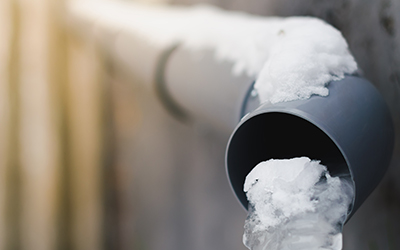
Cold-weather home damage
In winter, alternating periods of melting and freezing can lead to ice dams, causing considerable damage to your home.
Ice dams
Snow acts like an insulation layer on the roof above your attic. When snow melts above a warmed attic, water moves down to the cooler roof edge and soffit and freezes. Unless this water is allowed to drain properly, the resulting freezing can create ice dams on your roof.
Ice dams can cause damage to the shingles and soffit on your roof. As the ice dam spreads up the roof, water eventually works its way under shingles and enters the attic.
Once water enters the attic, there is a risk of damage to the roof, ceilings, walls and contents of your home. If ceiling insulation becomes wet, it loses its insulation value and can lead to a rise in the temperature of the attic, accelerating the growth of the ice dam.
Preventing ice dams
Proper ventilation and insulation of your attic helps keep the attic cool and may help avoid ice dams. Exhaust fans, ducts, chimneys, attic hatches and pipe penetrations can leak heat into your attic and contribute to the problem. Sealing around these areas can help. Contact a reputable contractor in your area for assistance.
The following tips can help you to prevent the creation of ice dams on your roof:
- In the fall, thoroughly clean all leaves and debris from your home’s gutters and downspouts. This will allow the melting snow to flow into the gutters and through the downspouts as intended.
- In the winter, keep the snow load on your roof to a minimum. Keeping the snow off your roof helps reduce the chance of your roof collapsing due to excessive snow load.
- Keep gutters and downspouts free of snow, ice buildup and icicles. This will allow a ready path for melted snow on your roof to drain, eliminating the potential for ice dam formation. This will also reduce the weight of ice and snow on the gutters and downspouts. Excessive weight can cause gutters and downspouts to pull away from the house or become damaged.
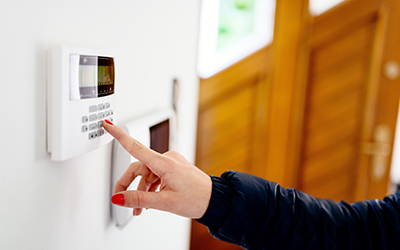
Break-in prevention
Having your home violated is a very traumatic experience. Break-ins cost Canadian insurance companies millions of dollars each year in claim payments. This cost is shared by policyholders through increased premiums.
Making a claim because of a break-in could increase your insurance premiums. By taking precautions to make your home more secure, you can save yourself inconvenience and money.
For instance, by installing a 24-hour monitored alarm system in your home, you reduce the chances of being a victim of crime. It also reduces your premiums as we provide an insurance premium discount to homeowners with a monitored alarm system.
Crime statistics
- A residential break-in happens every 90 seconds in Canada.
- More than 80% of break-ins occur during daylight hours.
- Most illegal entries are made by amateur burglars without the use of sophisticated tools.
- Most burglars enter through a basement or ground-floor door or window.
- Most burglars rely in concealment, speed and force to gain entry to a home.
Crime prevention tips
To best protect your home, look at it from a burglar’s perspective. What are the vulnerable parts? Burglary is always a crime of opportunity. Reduce your odds of being affected by crime by taking some preventative steps.
Crime proofing inside your home
The goal of indoor crime proofing is to secure your premises and make them appear occupied at all times. Here are a few simple tips to deter burglars from entering your home:
Secure your premises
- Close blinds and curtains at night so that a burglar can’t scope your belongings.
- Lock all doors and windows before leaving your house.
- Lock windows so that they can’t be opened from the outside. If they can’t be locked, you can pin them by drilling a hole through both window frames and inserting a bolt or metal pin. The pin must be easily removable for emergency situations.
Make your home look occupied at all times
- Use timers to maintain normal lighting patterns.
- Leave a radio on when you are away from your home for short periods of time.
Protect your valuables
- Consider marking or engraving your valuables with a unique identifier known only to you.
- Take an inventory of your home on a videotape and/or in photographs.
- Keep jewelry and negotiables in a safety deposit box or an unlikely place (e.g., not your bedroom).
Crime proofing outside your home
24-hour monitored alarm systems
There is no perfect deterrent to protect your home against a burglar. However, statistics show the chance of having your home broken into is significantly reduced if you have a 24-hour monitored alarm system.
Statistics also show that the amount of property stolen from homes equipped with a 24-hour monitored alarm system is less than that from homes without a monitored alarm system. Burglars just don’t have as much time to act when an alarm is activated.
A 24-hour monitored alarm system provides peace of mind and security for your entire family against the possibility of home intrusion, whether you’re home or not.
Alarm systems can also monitor smoke, fire, temperature change, carbon monoxide and water escape. Alarms get help there sooner, minimizing damage and danger.
Secure your premises
There are many things that you can do to the exterior of your house or in the yard to deter burglars and make it more difficult to force entry.
- Keep your shrubbery cut back so that it doesn’t block windows and doors.
- Illuminate as much of your property as possible.
- Exterior doors should be solid, not hollow. Metal doors provide the best protection against forced entry.
- Use a fencing style that would not conceal a burglar’s activities. Remember, if you can’t see out, others can’t see in.
- Secure any glass that is less than 40 inches from a door lock. Either coat exterior glass with an acrylic or polycarbonate to strengthen, or replace with laminated or tempered glass.
- Door hinges that are on the outside should have a non-removable centre pin that can’t be tampered with.
- Install deadbolt locks.
- Place hinged security bars over basement windows. Remember to keep the key nearby for emergency exits.
- Pin sliding patio doors together when closed. Another easy security step is to drill a hole in the upper track and insert a screw that extends out into the runner to prevent the door from being lifted up and out of its track.
- Ensure that a burglar cannot access the roof from high trees or a ladder left outside.
What not to do
- Don’t put up a nameplate outside of your house with your full name. A burglar can use this information to look up your number in the phone book and call to see if you are home.
- Don’t leave a note on the door or in the mailbox telling a friend or family member that you aren’t home.
- Don’t leave spare keys in an obvious place such as the mailbox or under the front door mat.
- Don’t leave cash and handbags in view in your home.
- Don’t leave any doors unlocked when you are at the other end of the house or in the yard.
While you are on vacation
If you are going on vacation, it’s especially important to make your home appear inhabited. Enlist the help of trusted neighbours, family and friends. Here are some things you can do to keep your home safer:
- Stop all mail delivery.
- Arrange for a neighbour to cut the grass or shovel snow.
- Cancel all deliveries during the time you will be away.
- Maintain normal lighting patterns by using electronic timers.
- Ask a neighbour to put one of their garbage bags in front of your house on collection day.
- Leave a radio on, with a timer if necessary to simulate normal use.
- Ask a neighbour to park in your driveway.
Arrange for neighbours to pick up flyers. - Don’t talk about your vacation plans with strangers or service people.
- Use your work address on your luggage tags so a potential burglar won’t know where your empty house is.
- Lock the garage door.
What to do if your home is burglarized
- Don’t stay – always think of your safety first.
- Never confront a burglar or block the exit route.
- Immediately go to a neighbour’s home or nearby location and phone the police.
- Upon the occurrence of a break-in to your home, and after the incident has been reported to the police, you should contact your insurance broker to arrange a time to meet with an adjuster.
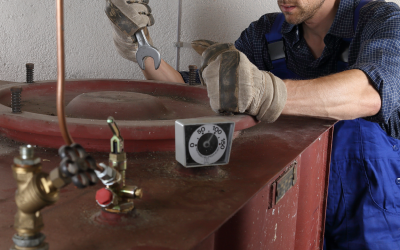
Leaking fuel oil tanks
More than 40% of all oil spills in Canada are from domestic oil tanks used to heat homes.
These heating fuel oil tanks deteriorate over time and most corrode from the inside out. This internal corrosion is caused by the accumulation of water and sludge at the bottom of the oil tank that can result in small pinhole leaks.
Dangers of fuel oil spills
- A leaking fuel oil tank is a serious fire and environmental hazard.
- Leaking oil can contaminate groundwater supplies. Just a few drops can contaminate a large volume of water.
- Fuel oil that has spilled into a basement can pose a serious health risk to indoor air quality.
- Cleaning up a spill from a fuel oil tank is expensive. In some cases, a cleanup can cost more than the property is worth.
Things to look for on your tank
If the answer to any of these questions is yes, contact a registered contractor immediately to have your tank inspected.
- Is your fuel oil tank unstable, resting on a combustible foundation or placed on something that’s not solid? Is it resting against a wall?
- Are their signs of rust or corrosion on the legs of the fuel tank?
- Are there signs of rust, corrosion, dents, weeping or dripping oil on the outside of the tank?
- Are there signs of leaks or spills around the fill pipe or vent pipe or by the tank itself?
- Is the fuel gauge for the tank missing, cracked or not working?
- Is the vent whistle on the fuel oil tank silent when the tank is being filled?
- Is there a strong smell of fuel oil near the tank?
- Does oil consumption seem higher than normal?
Fuel oil tank tips
- Ensure your oil tank is certified and approved for use as a fuel oil tank. If you have an outside tank, ensure it’s rated for outdoor use.
- Have a registered contractor properly install your fuel oil tank and have your tank inspected at least once a year.
Never purchase or install a used fuel oil tank. - If outside, ensure the top of the tank is clear of ice and snow.
- Ensure inactive fill pipes on the outside of your home are removed or capped.
- Consider replacing your fuel oil tank if it’s more than 15 years old.
What to do in case of a spill
- Eliminate all sources of ignition or open flames near the leak or spill.
- Contact a fuel oil supplier or registered heating contractor.
- Stop the leak if it can be done without risk.
- Contain spilled oil using whatever materials may be available such as pails, rags, cat litter, plastic garbage bags or other possible collection materials.
- Don’t allow spilled fuel oil to enter a floor drain, sewer or septic system.
- Transfer remaining oil from a leaking tank to a sound tank or other approved container made of leak-proof material.
- Clean up spilled oil and any contaminated solid material and place in leak-proof containers. For large spills, a professional contractor should be contacted.
- Properly dispose of old tanks, containers, recovered oil, contaminated soil or other materials as recommended by a qualified professional in accordance with environmental regulations.
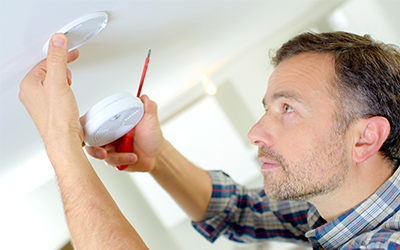
Fire prevention and safety
There are about 24,000 house fires per year in Canada. That equates to an average of 377 deaths and 3,048 injuries per year.
Facts about house fires
- In Canada, 1 out of 100 preventable residential fires are fatal.
- The No.1 ignition source in all preventable house fires is cooking equipment that ignites clothing, oil or flammable liquids.
- In fatal, preventable house fires, the No. 1 ignition source is smoking materials, such as cigarettes.
- Fires are most likely to start in the kitchen, bedrooms and the living room.
- In fatal, preventable house fires, more than 1/3 of the homes didn’t have an operating smoke detector.
Kitchen fires are common and preventable
- Have a fire extinguisher in your kitchen for small fires, and learn how to use it. If a grease fire occurs, remember to never use water as this will cause the hot grease to splatter, burning you or spreading the fire. Instead, smother it with a lid or another pan, then turn off the burner.
- Consider installing special stove top burners that have a high end heat limiting technology (HEHLT) on them which prevent the element from getting to a flammable temperature.
- Check out the video about preventing cooking oil and grease fires.
Protect your home and family
Take these measures in order to protect your home and family from the leading causes of fire loss:
- Prepare a fire escape plan for your family, outlining designated escape routes and a safe meeting place outside of your home.
- Teach your family fire safety and practice your fire plan frequently.
- Install smoke alarms and check monthly to make sure they’re working. Remember to change the batteries yearly.
- Never smoke in bed or in a place where you may fall asleep. Ensure all hot embers are in an ashtray and are extinguished before emptying it into the trash.
- Never leave a burning candle unattended and learn how to burn candles safely.
- Keep portable fire escape ladders in all upstairs bedrooms.
Store matches and lighters in a safe place, up high and out of the reach of children. - Never run cords under rugs or heavy furniture.
Inspect your home for fire hazards, such as overloaded electrical circuits, light bulbs with greater wattages than a light fixture is rated for or combustible items (like newspapers, cardboard and rags). Keep any combustible items away from all portable space heaters, water heaters, furnaces or other heat sources. - Always store flammable liquids in an approved container designed to store the liquid and in a locked, detached shed. Wipe up any spills immediately and never refuel motors near heat sources, sparks or cigarettes. Never use gasoline in your home or basement.
- If you operate a wood-burning appliance or fireplace, become thoroughly familiar with its safe operation and maintenance, and learn how to burn wood safely.
If a fire happens
- Put your fire escape plan into action and evacuate all members of your family.
- Phone your local fire department immediately, or dial 911.
- When it is safe to do so, contact your insurance broker to arrange for an adjuster to handle your claim.

